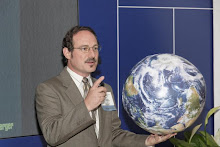Monday, May 25, 2009
Waiting on Technology?
An article in the New York Times in April (http://www.nytimes.com/2009/04/11/us/politics/11climate.html?_r=1) should remind all of us who are positioning ourselves to apply technology to the new CO2 sequestration segment of the industry that we are on the right track. In the article, Jonathan Pershing, U.S. Deputy Special Envoy for Climate Change, who was at the time leading a U.S. delegation to an international climate change conference in Germany, defended the American "lack of robust leadership" by explaining that the Obama administration was "waiting to measure the American technological ... capacity" and expecting Congress to set specific targets. Many of us expect either a carbon tax credit or cap and trade schemen in the next 6 months to drive the financial business case for applying what have traditionally been hydrocarbon extraction technologies from the oil and gas industry to new CO2 sequestration projects. Pershing has been at this post only since mid-March but brings, interestingly, a geology and geophysics degree to the position from the University of Minnesota. And he seems to know the oil business. In 2004, he gave a presentation at an "ENERGY, ENVIRONMENT AND ECONOMICS" conference of the IEEE, in which he showed the possibility of up to 4% reduction in shareholder value of various oil companies due to restricted access in sensitive areas, either closer to human populations, remote, or in terrestrial or marine ecoregions. It highlighted many companies that are now actively involved in "green" initiatives such as CO2 sequestration.
Sunday, May 24, 2009
Sea Ice
It seems some research soon to be published by Ken Golden at University of Utah and Hajo Eicken at the University of Alaska shows that permeability in sea ice is anisotropic and both temperature and salinity dependent. I am wondering if this means that someday we may be analyzing 4D seismic data to understand the properties of gas hydrates?
Monday, May 18, 2009
The Carbon Lifecycle
Just off of Interstate 45 on the Freestone-Leon County Line, there is a place where you can see the entire anthropogenic carbon cycle in a single vista. Pull off at exit 180 and take the service road on the west side of the highway north about 5 miles. You will pass turn-ins for producing oil fields operated by operated by XTO, Pinnacle, and Anadarko. At the top of a rise just before the power lines cross the highway, you can pull into entrance 52 of Texas Westmoreland Coal Co.’s Jewett Mine, though not into the mine itself (mind the No Trespassing signs!) Walk to the fence and look down into the creekbed to your left and you can see slowly decomposing mats of leaf litter and other organic material in a slow-running stream, that left to their own devices, in many millenia, could be the source rock for a future gneration's hydrocarbon resource. Then look up and across the fence to the 35,000 acre lignite dragline operation that is continuously and voraciously scooping up the results of that process from the Eocene, and out to the horizon where the Limestone Electric Generating Station burns that stored energy to generate electricity and returns much of the carbon to the atmosphere as CO2. listen to the hum of the electricity in the high-tension wires over your head as the result of that energy process flows out to the cities and towns of southeast Texas, much of it to power equipment in the pumping oil wells that you passed just down the road. Now allow yourself to think about how much organic content is burned up every hour and how long it will take to renew, and you start to get a feel for the geologic time scale and how quickly we are altering it... I recommend that every Texas school child whose education is financed by oil and gas revenues have the opportunity to see first hand this cycle at work ...
Friday, May 15, 2009
What, me Worry?
At the PNEC Data Management conference here in Houston this week, the organizers left out at everyone's seat on the first day a copy of the Digital Energy Journal highlighting a quote from Bob Bloom of National Oilwell Varco, saying "I don't worry about the 'great crew change'". I wondered why he wasn't worried so I did a little research and found that while he was headed off to this Drilling Conference in Amsterdam, rumors were swirling about layoffs of more than 100 people at Varco's production facility in Texas. So of course Bob wasn't personally worried. He was, in the words of one attendee commenting on similar recent layoffs at Schlumberger, "paving the way for his next job" by forcing cuts of experienced workers close to being vested in their pension plans. So as noted by one of the speakers at the conference, don't worry about the great crew change, it will come and find you... and it won't be so great!
Subscribe to:
Comments (Atom)
